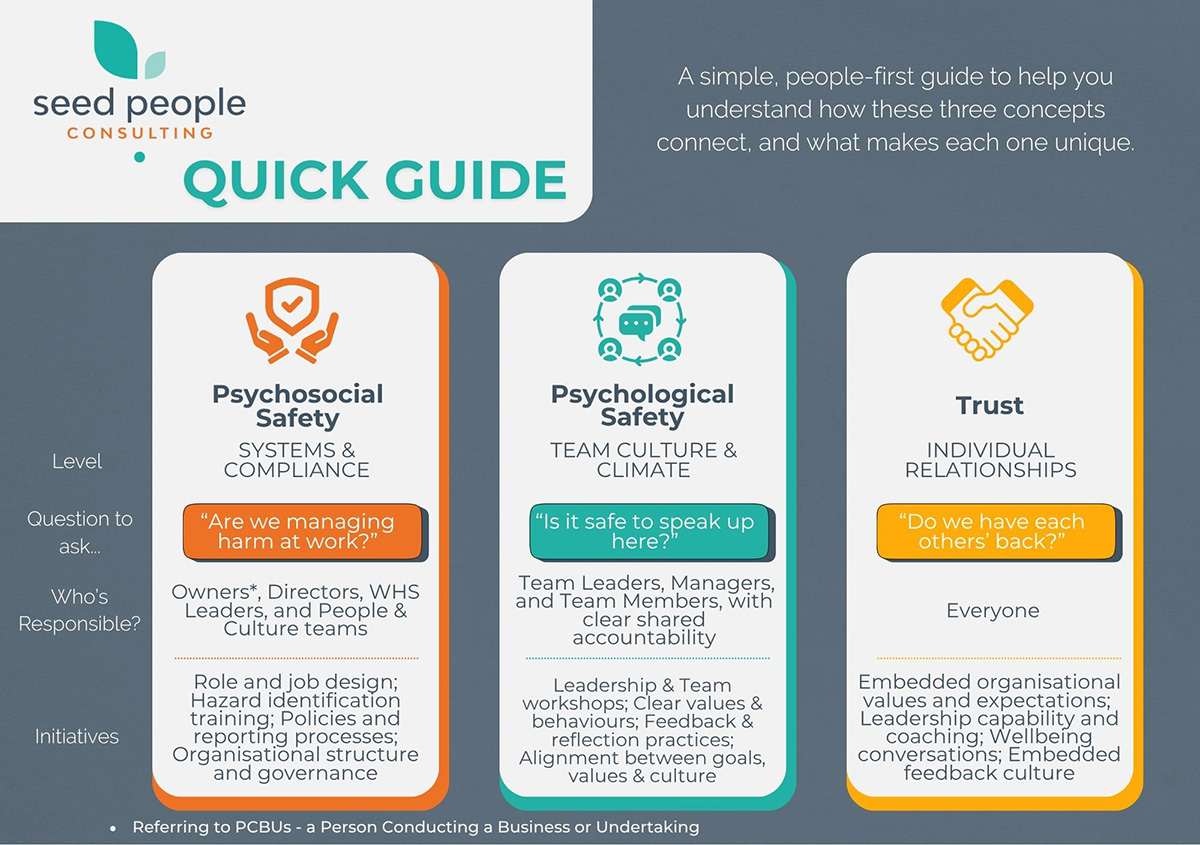Psychosocial Safety, Psychological Safety and Trust: What’s the Difference – and Why it Really Matters
If you feel like these three terms get thrown around like they’re interchangeable, you’re not the only one. They’re definitely related, but not the same, and getting a handle on the differences is essential to meeting your legal duties, building teams that genuinely thrive, and boosting performance.
In this article, we’ll delve into the various aspects of team development, psychosocial safety, and trust, highlighting how each one contributes to a team’s overall effectiveness and boosts your organisational performance.
Three Concepts, Three Levels
1) Psychosocial Safety and Psychosocial Hazards in Australia (The Legal Stuff)
This is all about your responsibility to prevent harm from psychosocial hazards – things like excessive job demands, unclear roles, poor support, bullying, or exposure to traumatic events. If these hazards aren’t properly managed at work, they can lead to all sorts of problems, like stress-related mental health issues (like anxiety and depression) or physical injuries (including musculoskeletal issues and chronic fatigue).
In Australia, PCBUs (a Person Conducting a Business or Undertaking) have specific WHS duties as part of their legal responsibilities to identify, assess and control psychosocial risks “as far as is reasonably practicable”, with guidance from the national Model Code of Practice and state/territory regulations. In NSW, for example, psychosocial risk provisions were introduced in 2022, with a new Code of Practice to help you do the right thing. (Safe Work Australia, SafeWork NSW)
Think about: risk management, controls and governance (policies, workloads, job design, supervision, complaints handling).
If you don’t get it right, there’s a risk of regulatory action, injuries, compensation claims and reputational damage. And, sadly, there have been some high-profile examples of this in action. (The Guardian, The Daily Telegraph)
2) Psychological Safety in Team Development (Building a Healthy Team Climate)
While the concept has earlier roots, Professor Amy Edmondson is widely credited with coining the concept of psychological safety. Psychological safety is basically a shared understanding that it’s okay to speak up – to ask questions, admit mistakes and share ideas, without fear of retribution or being punished. It’s not about being nice or avoiding conflict; it’s about being open and honest to help your team learn and perform better.
As Amy Edmondson explored in her Harvard Business School article, ‘What People Get Wrong about Psychological Safety’, when you’ve got a team with high psychological safety, you can expect better problem-solving, faster learning and smarter decisions.
Team development typically goes through a few stages (a simplified version of Bruce Tuckman’s model):
- the storming stage, where conflicts and disagreements come out as team members figure out the team’s goals and their own roles;
- the norming stage, where conflicts are resolved, roles are clarified, and cohesion is built through collaboration and trust;
- and the performing stage, where the team is humming along, leadership is strong, and cooperation and productivity are flying high.
Each stage contributes to psychological safety by building trust, clarifying expectations, and supporting open communication among team members.
Positive team experience, effective teamwork and clear team expectations all contribute to psychological safety by fostering trust, open communication and a shared understanding of how team members interact and perform together. Having a strong team leader and clarifying individual roles is key to supporting teamwork and keeping everyone aligned with the team’s goals.
Think about: team norms, constructive criticism, a bit less structure, meeting design, leadership behaviours (inviting input, responding well to bad news). If you don’t get this right, you can expect silence, risk blindness, slow improvement and stalled innovation.
Having psychological safety also enables teams to solve problems more effectively, as team members feel empowered to contribute ideas, share feedback and learn from each other.
3) Trust (Relationship Quality)
Trust is basically an individual’s willingness to be vulnerable based on how they judge another’s ability>benevolence and integrity (the classic Mayer–Davis–Schoorman model). Trust operates on a personal level, between individual team members, and between leaders and teams. It’s the foundation for influence, change and follow-through.
Think about: credibility, care and consistency in relationships; respecting and maintaining boundaries; keeping your word; making fair decisions. If you neglect trust, you can expect politics, second-guessing, slow execution and churn.
How They Connect – and How They Differ
- Level: psychosocial safety = system & compliance; psychological safety = team climate; trust = interpersonal
- Primary question: “Are we managing harm at work?” → “Is it safe to speak up here?” → “Do I trust you?”
- Owner: officers/PCBUs & WHS leaders → team leaders & members (with clear responsibilities) → every relationship
- Interventions: controls and job/organisation design → facilitation, feedback norms and inclusive leadership (with clear team goals and alignment to the team’s mission) → leader credibility, care and integrity
For example, some practical interventions might include regular team check-ins to assess psychological safety, anonymous feedback tools to surface concerns, or structured team-building activities to foster trust. These are the kinds of things that can actually help your team move forward through each development phase.
These layers are a big part of what reinforces each other. Strong controls (psychosocial safety measures) cut down on the things that can go wrong, making it way easier for teams to build a sense of psychological safety; having leaders that people can really trust makes it a whole lot simpler for people to speak up; and when teams do speak up, they can spot potential hazards before they even become a problem – which helps send that info back to the WHS risk management process.
Keeping your finger on the pulse of how teams are doing and where they are in the development process is also super important – it helps you figure out where things are going wrong, keep the team motivated, and make sure they’re continuously getting better as they move on to the next stage.
Why nailing the difference really matters
Compliance is just the beginning – culture is what really counts. Meeting the minimum standards on psychosocial hazards is one thing, but being a place where people feel safe to challenge the status quo and where leaders actually earn the trust of their teams is a whole different story and something you need to get right.
Getting the right solution to the right problem. If you slap a ‘psychological safety’ label on a workload issue, you might end up running workshops on something that really needs a workover. On the other hand, if you treat a fear of speaking up as some sort of ‘WH&S hazard’, you could end up tossing in safety controls when what’s really needed is some top-notch facilitation and leadership training – just what the doctor ordered.
Accountability in the clear. Boards and executives have to keep a close eye on psychosocial risk; line leaders need to make psychological safety a top priority; every manager needs to earn and hold onto the trust of their team.
Team growth – moving beyond just following the rules
Team growth is a critical point in team development where the focus shifts from just doing what’s required to genuinely working together towards a shared goal. At this stage, team members start to move away from purely focusing on their individual tasks and begin working collaboratively towards a common goal. This transition is key to building teams that not just meet compliance requirements but thrive even in tough environments.
Team leaders have a huge part to play here by creating an environment that’s built on trust, open communication and psychological safety. By actively managing psychosocial hazards such as unreasonable behaviour, excessive workloads, or a lack of support, they help reduce the risk of both psychological and physical harm. This, in turn, creates a healthier and safer environment that looks after both mental health and team performance.
Getting good team development strategies in place – such as healthy disagreement norms, conflict resolution methods and shared leadership – gives team members the tools they need to address conflicts in a constructive way and take collective responsibility for the team’s progress. As teams start to use these practices, they become more resilient, adaptable and better at solving complex problems together. Ultimately, moving beyond compliance allows teams to achieve lasting value, hit their team goals, and support the well-being of every single member.
Getting norms in place for safety and trust
Getting clear norms in place for safety and trust is a foundation for building a positive team culture. During the forming stage of team development, team members are still trying to get a handle on their roles and expectations – and often look to team leaders for guidance. By setting clear expectations and creating a supportive environment from the get-go, leaders give team members the confidence to express their concerns, share their ideas and participate fully in team processes.
This early focus on safety and trust is vital for stopping psychosocial hazards like bullying, exclusion or unreasonable demands from taking hold – all of which can create stress and increase the risk of psychological harm. As the team moves through the storming and norming stages, establishing norms that build trust, enable constructive criticism, conflict resolution, and collaborative problem solving, which becomes even more essential. These practices don’t just improve team performance – they also strengthen relationships and embed trust between members.
By prioritising safety and trust at every stage, teams create a culture where every single member feels valued and supported. This approach not only reduces risks but also lays the groundwork for high-performing teams that can adapt, innovate and get the job done together.
What good looks like (some practical starting points)
- Map your risks: Use the Psychosocial Model Code of Practice to identify and control psychosocial hazards – think things like job demands, role clarity, remote work isolation, exposure to aggression and so on.
- Intentionally design your work: Balance demands and resources, make sure roles are clear, define each task clearly and give team members the right tools and support to work independently. Clearly defining team tasks helps teams navigate responsibilities and resolve conflicts – especially during the challenging stages of team development. Set manageable workloads and make sure team members have the chance to have a say in their work design, with coaching support and leadership.
- Make speaking up normal: Build team habits – like check-ins, learning reviews and “red flag” slots – so candour is the norm and every team member feels encouraged to participate in these habits.
- Lead for trust: Show your team you’re competent, that you care about them and that you’re consistent in your actions. Be transparent about your decisions, own your mistakes (including making right on whatever the mistake was) and keep your promises.
- Follow through: When people raise risks or ideas, respond, act and report back. There’s nothing that erodes safety and trust faster than silence.
- Govern well: Track leading indicators (workload, leave, incidents) and lagging ones (injury claims, turnover). Review your controls and culture regularly at Exec and Board level.
The culture impact – at a glance
- Doing psychosocial safety right: lower harm, fewer incidents and claims, and a healthier baseline for work. Regulators are definitely paying attention – and acting – so the stakes are high. (The Guardian)
- Getting psychological safety right: more learning, fewer repeats of the same mistakes, faster innovation and better client outcomes. (Harvard Business Review)
- Building trust: quicker decisions, cleaner accountability and stronger engagement – because people don’t waste energy protecting themselves. (makinggood.ac.nz)
These positive outcomes can also influence other teams across the organisation, creating a ripple effect of improved culture and safety.
How we can help
Seed People Consulting and our selected partners support organisations to connect all three layers: compliance (psychosocial risk assessment and control design), team climate (speaking up habits and inclusive leadership) and trust (leader credibility and cohesion); so your culture is both safe and high-performing.





